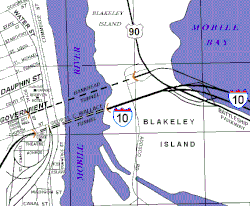This article needs additional citations for verification .(April 2017) |
 Map of the Wallace (lower) and Bankhead (upper) tunnels under the Mobile River. | |
 | |
| Overview | |
|---|---|
| Official name | George Corley Wallace Tunnel |
| Other name | Wallace Tunnel |
| Location | Mobile River, Mobile, Alabama |
| Coordinates | 30°41′24″N88°02′08″W / 30.69000°N 88.03556°W |
| Route | four lanes of |
| Operation | |
| Opened | February 9, 1973 |
| Traffic | 78,775 (2015) |
| Character | Dual four-lane road tunnel |
| Toll | none |
| Technical | |
| Length | 3,000 feet (914 m) |
| No. of lanes | 4 |
| Operating speed | 55 miles per hour (89 km/h) |
| Tunnel clearance | 16 feet (5 m) |
| Depth of tunnel below water level | 40 feet (12 m) (from surface to top of tunnel) |
The George Wallace Tunnel is a pair of road tunnels that carry Interstate 10 through Mobile, Alabama from the city's downtown, going beneath the Mobile River, and emerging on Blakeley Island where they join the Jubilee Parkway over Mobile Bay. [1]
Contents
It, like the smaller Bankhead Tunnel a few blocks upriver from it, was constructed in Mobile at the shipyards of the Alabama Drydock and Shipbuilding Company (ADDSCO) from 1969 to 1973. [1] The George Corley Wallace Tunnel, actually two separate tunnels (one for two lanes of travel eastbound, and one for two lanes of travel westbound on Interstate 10), was built in sections and floated to the proper positions, then sunk. Each section was sunk next to the previous section and joined underwater. When all sections were connected, and concrete set into place, they were pumped dry and finished out. The depth of clearance is 40 ft (12.2 m) for the ship channel over the tunnel. [1] This is the same clearance as the older Bankhead Tunnel.
The tunnel was officially opened to traffic on February 9, 1973, after $50 million ($291.8 million in 2020 dollars) was spent to construct it. [2] It was named after George Wallace, the Governor of Alabama at the time. [2]

